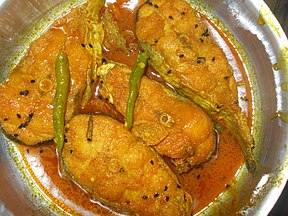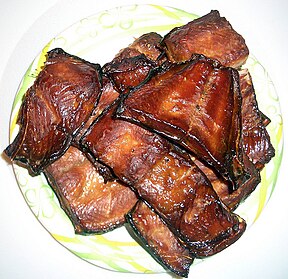Fish as food
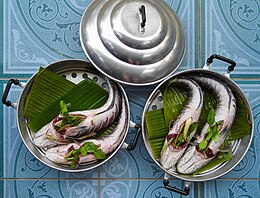
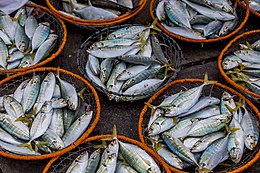
Many species of fish are caught by humans and consumed as food in virtually all regions around the world. Fish has been an important dietary source of protein and other nutrients.
The English language does not have a special culinary name for food prepared from fish like with other animals (as with pig vs. pork), or as in other languages (such as Spanish pez vs. pescado). In culinary and fishery contexts, fish may include so-called shellfish such as molluscs, crustaceans, and echinoderms; more expansively, seafood covers both fish and other marine life used as food.[1]
Since 1961, the average annual increase in global apparent food fish consumption (3.2 percent) has outpaced population growth (1.6 percent) and exceeded consumption of meat from all terrestrial animals, combined (2.8 percent) and individually (bovine, ovine, porcine, etc.), except poultry (4.9 percent). In per capita terms, food fish consumption has grown from 9.0 kg (19.8 lb) in 1961 to 20.2 kg (45 lb) in 2015, at an average rate of about 1.5 percent per year.[2] The expansion in consumption has been driven not only by increased production, but also by a combination of many other factors, including reduced wastage, better utilization, improved distribution channels and growing consumer demand, linked with population growth, rising disposable incomes and urbanization.[2]
Europe, Japan and the United States of America together accounted for 47 percent of the world's total food fish consumption in 1961, but only about 20 percent in 2015. Of the global total of 149 million tonnes in 2015, Asia consumed more than two-thirds (106 million tonnes at 24.0 kg per capita).[2] Oceania and Africa consumed the lowest share. The shift is the result of structural changes in the sector and in particular the growing role of Asian countries in fish production, as well as a significant gap between the economic growth rates of the world's more mature fish markets and those of many increasingly important emerging markets around the world, particularly in Asia.[2]
Species
[edit]Over 32,000 species of fish have been described,[3] making them the most diverse group of vertebrates. In addition, there are many species of shellfish. However, only a small number of species are commonly eaten by humans.[citation needed]
Preparation
[edit]Fish can be prepared in a variety of ways. It can be served uncooked (raw food, e.g., sashimi); cured by marinating (e.g., ceviche), pickling (e.g., pickled herring) or smoking (e.g., smoked salmon); or cooked by baking, frying (e.g., fish and chips), grilling, poaching (e.g., court-bouillon) or steaming. Many of the preservation techniques used in different cultures have since become unnecessary but are still performed for their resulting taste and texture when consumed.[citation needed]
The British historian William Radcliffe wrote in Fishing from the Earliest Times:
"The Emperor Domitian (Juvenal, IV.) ordered a special sitting of the Senate to deliberate and advise on a matter of such grave State importance as the best method of cooking a turbot."[5]
Nutritional value
[edit]| Comparison of nutrients in 100 g of whitefish or oily fish | |||
|---|---|---|---|
| Nutrient | Whitefish Alaska pollock[6] |
Oily fish Atlantic herring[7] |
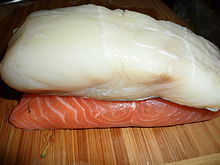 |
| Energy (kcal) | 111 | 203 | |
| Protein (g) | 23 | 23 | |
| Fat (g) | 1 | 12 | |
| Cholesterol (mg) | 86 | 77 | |
| Vitamin B-12 (μg) | 4 | 13 | |
| Phosphorus (mg) | 267 | 303 | |
| Selenium (μg) | 44 | 47 | |
| Omega-3 (mg) | 509 | 2014 | |
Globally, fish and fish products provide an average of only about 34 calories per capita per day. However, more than as an energy source, the dietary contribution of fish is significant in terms of high-quality, easily digested animal proteins and especially in fighting micronutrient deficiencies.[2] A portion of 150g of fish provides about 50 to 60 percent of an adult's daily protein requirement. Fish proteins are essential in the diet of some densely populated countries where the total protein intake is low, and are particularly important in diets in small island developing States (SIDS).[2]
Intermediate Technology Publications wrote in 1992 that "Fish provides a good source of high quality protein and contains many vitamins and minerals. It may be classed as either whitefish, oily fish, or shellfish. Whitefish, such as haddock and seer, contain very little fat (usually less than 1%) whereas oily fish, such as sardines, contain between 10–25%. The latter, as a result of its high fat content, contain a range of fat-soluble vitamins (A, D, E and K) and essential fatty acids, all of which are vital for the healthy functioning of the body."[8]
Health benefits
[edit]Eating oily fish containing long-chain omega-3 fatty acids may reduce systemic inflammation and lower the risk of cardiovascular disease.[9][10] Eating about 140 grams (4.9 oz) of oily fish rich in omega-3 fatty acids once per week is a recommended consumption amount.[9][10] Increasing intake of omega-3 fatty acids may slightly reduce the risk of a fatal heart attack,[10] but likely has little effect on the overall number of deaths from cardiovascular disease.[11]
Health hazards
[edit]Fish bone is the most common food-related foreign body to cause airway obstruction. Choking on fish was responsible for about 4,500 reported accidents in the United Kingdom in 1998.[12]
Allergens
[edit]A seafood allergy is a food allergy to allergens which can be present in fish. This can result in an overreaction of the immune system and lead to severe physical symptoms[13] from urticaria to angioedema and distributive shock. Allergic reactions can result from ingesting seafood, or by breathing in vapours from preparing or cooking seafood.[14] The most severe allergic reaction is anaphylaxis, a medical emergency requiring immediate attention and is treated urgently with epinephrine.[15]
Biotoxins
[edit]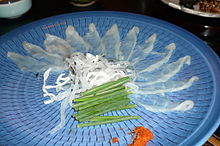
Some species of fish, notably the fugu pufferfish used for sushi, can result in serious food poisoning if not prepared properly. These fish always contain toxins as a natural defense against predators; it is not present due to environmental circumstances. Particularly, fugu has a lethal dose of tetrodotoxin in its internal organs and must be prepared by a licensed fugu chef who has passed the national examination in Japan. Ciguatera poisoning can occur from eating larger fish from warm tropical waters, such as sea bass, grouper, barracuda and red snapper.[16] Scombroid poisoning can result from eating large oily fish which have sat around for too long before being refrigerated or frozen. This includes scombroids such as tuna and mackerel, but can also include non-scombroids such as mahi-mahi and amberjack.[16] The poison is often odourless and tasteless.[17]
Many fish eat algae and other organisms that contain biotoxins, which are defensive substances against predators. Biotoxins accumulated in fish/shellfish include brevetoxins, okadaic acid, saxitoxins, ciguatoxin and domoic acid. Except for ciguatoxine, high levels of these toxins are only found in shellfish. Both domoic acid and ciguatoxine can be deadly to humans; the others will only cause diarrhea, dizziness and a (temporary) feeling of claustrophobia.[18][19]
Shellfish are filter feeders and, therefore, accumulate toxins produced by microscopic algae, such as dinoflagellates and diatoms, and cyanobacteria. There are four syndromes called shellfish poisoning which can result in humans, sea mammals and seabirds from the ingestion of toxic shellfish. These are primarily associated with bivalve molluscs, such as mussels, clams, oysters and scallops.[20] Fish like anchovies can also concentrate toxins such as domoic acid.[21] If suspected, medical attention should be sought.
| Poisoning type | Symptoms | Duration | Toxin | Antidote | Sources | |
|---|---|---|---|---|---|---|
| Fish | Ciguatera | Nausea, vomiting and diarrhea, usually followed by headaches, muscle aches, paresthesia, numbness, ataxia, vertigo, and hallucinations. | Weeks to years | Ciguatoxin and similar: maitotoxin, scaritoxin and palytoxin | None known | [17][22] |
| Scombroid food poisoning |
Skin flushing, throbbing headache, oral burning, abdominal cramps, nausea, diarrhea, palpitations, sense of unease, and, rarely, collapse or loss of vision. Symptoms occur usually within 10–30 minutes of ingesting spoiled fish. | Usually four to six hours | Histamine, possibly others | Oral anti-histamines | [22][23] | |
| Haff disease | Rhabdomyolysis, that is, a swelling and breakdown of skeletal muscle (with a risk of acute kidney failure) within 24 hours after consuming fish | A toxic cause is suspected but has not been proven | None known | [24] | ||
| Ichthyo- allyeinotoxism |
Vivid auditory and visual hallucinations similar in some aspects to LSD. | Can last for several days | [25] | |||
| Shellfish | Amnesic | Permanent short-term memory loss and brain damage | Fatal in severe cases | Domoic acid, which acts as a neurotoxin | None known | [22] |
| Diarrheal | Diarrhea and possibly nausea, vomiting and cramps. | Symptoms usually set in within half an hour and last about a day | Okadaic acid, which inhibits intestinal cellular de-phosphorylation. | [26] | ||
| Neurotoxic | Vomiting and nausea and a variety of neurological symptoms such as slurred speech. Not fatal though it may require hospitalization. | Brevetoxins or brevetoxin analogs | [27][28] | |||
| Paralytic | Includes nausea, vomiting, diarrhea, abdominal pain, and tingling or burning sensations. Other symptoms also possible. | Occasionally fatal | Principal toxin saxitoxin | 4-Aminopyridine has been used in non-human animals.[29][30][31] | [32] |
The toxins responsible for most shellfish and fish poisonings, including ciguatera and scombroid poisoning, are heat-resistant to the point where conventional cooking methods do not eliminate them.[17]
Mercury and other toxic metals
[edit]Fish products, especially those from apex and higher-order consumers up the food chain, have been shown to contain varying amounts of heavy or toxic metals due to biomagnification. Toxicity is a function of solubility, and insoluble compounds often exhibit negligible toxicity. Organometallic forms such as dimethyl mercury and tetraethyl lead can be extremely toxic.[33]
| Mercury level | Low < 0.04 ppm |
Medium 0.04–0.40 ppm |
High > 0.40 ppm |
|---|---|---|---|
| Omega-3 | |||
| High > 1.0% |
salmon sardine |
Atlantic mackerel flatfish halibut herring |
Spanish mackerel swordfish tilefish |
| Medium 0.4–1.0% |
pollock | hoki tuna |
king mackerel shark |
| Low < 0.4% |
catfish shrimp |
cod snapper tuna canned light |
grouper orange roughy |
| mercury/omega-3 levels in commercial fish and shellfish | |||||||
|---|---|---|---|---|---|---|---|
| species | mercury[35] (mean ppm) |
omega-3[36][37] (mean percent) |
habitat | notes | trophic level[38] |
max age (years)[38] | |
| Tilefish | 1.450 | 1.06 | pelagic | 3.6 | 35 | ||
| Swordfish | 0.995 | 1.14 | pelagic | 4.5 | 15 | ||
| Shark | 0.979 | 0.98 | pelagic | ||||
| King mackerel | 0.730 | 0.42 | pelagic | 4.5 | 14 | ||
| Orange roughy | 0.571 | 0.033 | demersal | 4.3 | 149 | ||
| Marlin | 0.485 * | pelagic | 4.5 | ||||
| Mackerel (Spanish) | 0.454 | 1.65 | pelagic | 4.5 | 5 | ||
| Grouper | 0.448 | 0.27 | demersal | 4.2 | |||
| Tuna | 0.391 | 0.77 | pelagic | All species, fresh/frozen | |||
| Patagonian toothfish | 0.354 | demersal | 4.0 | 50+[39] | |||
| Halibut | 0.241 | 1.01 | demersal | 4.3 | |||
| Snapper | 0.166 | 0.26 | demersal | ||||
| Bass | 0.152 | demersal | 3.9 | ||||
| Perch | 0.150 | freshwater | 4.0 | ||||
| Tuna | 0.128 | 0.24 | pelagic | All species, canned, light | |||
| Perch (ocean) | 0.121 * | demersal | |||||
| Cod | 0.111 | 0.23 | demersal | 3.9 | 22 | ||
| Carp | 0.110 | freshwater | |||||
| Lobster (American) | 0.107 | demersal | |||||
| Lobster (spiny) | 0.093 | demersal | |||||
| Whitefish | 0.089 | demersal | |||||
| Herring | 0.084 | 1.94 | pelagic | 3.2 | 21 | ||
| Trout | 0.071 | freshwater | |||||
| Crab | 0.065 | demersal | Blue, king and snow crab | ||||
| Hoki (blue grenadier) | 0.058 | 0.48 | demersal | 3.5 | |||
| Flatfish | 0.056 * | 0.56 | demersal | Flounder, plaice and sole | |||
| Haddock | 0.055 | demersal | Atlantic | ||||
| Atlantic mackerel | 0.050 | 1.64 | pelagic | ||||
| Mullet | 0.050 | pelagic | |||||
| Pollock | 0.031 | 0.53 | demersal | ||||
| Catfish | 0.025 | 0.31 | demersal | 3.9 | 24 | ||
| Squid | 0.023 | pelagic | |||||
| Salmon | 0.022 * | 1.76 | pelagic | Fresh/frozen | |||
| Anchovies | 0.017 | pelagic | 3.1 | ||||
| Sardine | 0.013 | 1.94 | pelagic | 2.7 | |||
| Tilapia * | 0.013 | freshwater | |||||
| Oyster | 0.012 | demersal | |||||
| Clam * | 0.009 | demersal | |||||
| Salmon | 0.008 * | pelagic | Canned | ||||
| Scallop | 0.003 | demersal | |||||
| Shrimp | 0.001 * | 0.12 | demersal | 6.5[40] | |||
| Greenshell mussel | 0.35 | demersal | |||||
| Sydney rock oyster | 1.11 | demersal | |||||
| * indicates methylmercury only was analyzed (all other results are for total mercury) | |||||||
According to the US Food and Drug Administration (FDA), the risk from mercury by eating fish and shellfish is not a health concern for most people.[41] However, certain seafood contains sufficient mercury to harm an unborn baby or young child's developing nervous system. The FDA makes three recommendations for child-bearing women and young children:
- Do not eat shark, swordfish, king mackerel, or tilefish because they contain high levels of mercury.
- Eat up to 12 ounces (2 average meals) a week of a variety of fish and shellfish that are lower in mercury. Four of the most commonly eaten fish that are low in mercury are canned light tuna, salmon, pollock, and catfish. Another commonly eaten fish, albacore ("white tuna") has more mercury than canned light tuna. So, when choosing your two meals of fish and shellfish, you may eat up to 6 ounces (one average meal) of albacore tuna per week.
- Check local advisories about the safety of fish caught by family and friends in your local lakes, rivers, and coastal areas. If no advice is available, eat up to 6 ounces (one average meal) per week of fish you catch from local waters, but do not consume any other fish during that week.
These recommendations are also advised when feeding fish and shellfish to young children, but in smaller portions.[41]
Mislabelling
[edit]When the ocean conservation organization Oceana examined over 1,200 seafood samples of seafood sold in the U.S. between 2010 and 2012, they found one-third were mislabelled. The highest rate of mislabelling occurred with snapper at 87 percent, followed by tuna at 57 percent.[42]
Persistent organic pollutants
[edit]If fish and shellfish inhabit polluted waters, they can accumulate other toxic chemicals, particularly fat-soluble pollutants containing chlorine or bromine, dioxins or PCBs.
Parasites
[edit]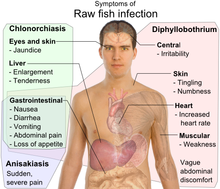
Parasites in fish are a common natural occurrence. Though not a health concern in thoroughly cooked fish, parasites are a concern when consumers eat raw or lightly preserved fish such as sashimi, sushi, ceviche and gravlax. The popularity of such raw fish dishes makes it important for consumers to be aware of this risk. Raw fish should be frozen to an internal temperature of −20 °C (−4 °F) for at least 7 days to kill parasites; home freezers may not be cold enough.[47][48]
Historically, fish that live all or part of their lives in fresh water were considered unsuitable for sashimi due to the possibility of parasites (see Sashimi article). Parasitic infections from freshwater fish are a serious problem in some parts of the world, particularly Southeast Asia[citation needed]. Fish that spend part of their life cycle in brackish or fresh water, like salmon (an anadromous coastalfish closely related to trout), are a particular problem. A study in Seattle, Washington showed that 100% of wild salmon had roundworm larvae capable of infecting people. In the same study farm-raised salmon did not have any roundworm larvae.[49]
Parasite infection from raw fish is rare in the developed world (fewer than 40 cases per year in the United States[citation needed]), and involves mainly three kinds of parasites: Clonorchis sinensis (a trematode/fluke), Anisakis (a nematode/roundworm) and Diphyllobothrium (a cestode/tapeworm). Infection risk of Anisakis is particularly high in fish which may have lived in a river or estuary, such as salmon (sa ke in Japanese cuisine) or mackerel (sa ba in Japanese cuisine). Such parasite infections can generally be avoided by boiling, grilling, preserving in salt or vinegar, or deep-freezing. In Japan, it is common to eat raw salmon and ikura (roe), but these foods are frozen overnight prior to eating to prevent infections from parasites, particularly Anisakis.[citation needed]
Pescetarianism
[edit]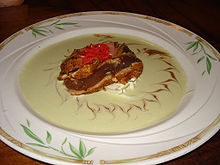
The neologism "pescetarian" covers those who eat fish and other seafood, but not mammals and birds.[50]
A 1999 metastudy combined data from five studies from western countries. The metastudy reported mortality ratios, where lower numbers indicated fewer deaths, for pescetarians to be 0.82, vegetarians to be 0.84, and occasional meat eaters to be 0.84. Regular meat eaters and vegans shared the highest mortality ratio of 1.00. However, the "lower mortality was due largely to the relatively low prevalence of smoking in these [vegetarian] cohorts".[51]
Since fish is animal flesh, the Vegetarian Society has stated that vegetarian diets cannot contain fish.[52]
In religion
[edit]Religious rites and rituals regarding food also tend to classify the birds of the air and the fish of the sea separately from land-bound mammals.[53] Sea-bound mammals are often treated as fish under religious laws – as in Jewish dietary law, which forbids the eating of cetacean meat, such as whale, dolphin or porpoise, because they are not "fish with fins and scales"; nor, as mammals, do they chew their cud and have cloven hooves, as required by Leviticus 11:9–12. Jewish (kosher) practice treats fish differently from other animal foods. The distinction between fish and "meat" is codified by the Jewish dietary law of kashrut, regarding the mixing of milk and meat, which does not forbid the mixing of milk and fish. Modern Jewish legal practice (halakha) on kashrut classifies the flesh of both mammals and birds as "meat"; fish are considered to be parve, neither meat nor a dairy food. (The preceding portion refers only to the halakha of Ashkenazi Jews; Sephardic Jews do not mix fish with dairy.)[citation needed]
Ichthys has become a symbol of Christianity since ancient times. In the New Testament Luke 24 – Jesus's eating of a fish [Luke 24] and Jesus telling his disciples where to catch fish, before cooking it for them to eat. Seasonal religious prohibitions against eating meat do not usually include fish. For example, non-fish meat was forbidden during Lent and on all Fridays of the year in pre-Vatican II Roman Catholicism, but fish was permitted (as were eggs). (See Fasting in Catholicism.) In Eastern Orthodoxy, fish is permitted on some fast days when other meat is forbidden, but stricter fast days also prohibit fish with spines, while permitting invertebrate seafood such as shrimp and oysters, considering them "fish without blood".[citation needed]
Some Buddhists and Hindus (Brahmins of West Bengal, Odisha and Saraswat Brahmins of the Konkan) abjure meat that is not fish. Muslim (halal) practice also treats fish differently from other animal foods, as it can be eaten without requiring the ritualistic slaughter that is prescribed for other halal animals.[54]
Environmental impact of fish consumption
[edit]Taboos on eating fish
[edit]Among the Somali people, most clans have a taboo against the consumption of fish, and do not intermarry with the few occupational clans that do eat it.[55][56]
There are taboos on eating fish among many upland pastoralists and agriculturalists (and even some coastal peoples) inhabiting parts of southeastern Egypt, Ethiopia, Eritrea, Somalia, Kenya, and northern Tanzania. This is sometimes referred to as the "Cushitic fish-taboo", as Cushitic speakers are believed to have been responsible for the introduction of fish avoidance to East Africa, though not all Cushitic groups avoid fish. The zone of the fish taboo roughly coincides with the area where Cushitic languages are spoken, and as a general rule, speakers of Nilo-Saharan and Semitic languages do not have this taboo, and indeed many are watermen.[56][57] The few Bantu and Nilotic groups in East Africa that do practice fish avoidance also reside in areas where Cushites appear to have lived in earlier times. Within East Africa, the fish taboo is found no further than Tanzania. This is attributed to the local presence of the tsetse fly and in areas beyond, which likely acted as a barrier to further southern migrations by wandering pastoralists, the principal fish-avoiders. Zambia and Mozambique's Bantus were therefore spared subjugation by pastoral groups, and they consequently nearly all consume fish.[56]
There is also another center of fish avoidance in Southern Africa, among mainly Bantu speakers. It is not clear whether this disinclination developed independently or whether it was introduced. It is certain, however, that no avoidance of fish occurs among southern Africa's earliest inhabitants, the Khoisan. Nevertheless, since the Bantu of southern Africa also share various cultural traits with the pastoralists further north in East Africa, it is believed that, at an unknown date, the taboo against the consumption of fish was similarly introduced from East Africa by cattle-herding peoples who somehow managed to get their livestock past the aforementioned tsetse fly endemic regions.[56]
Certain species of fish are also forbidden in Judaism such as the freshwater eel (Anguillidae) and all species of catfish. Although they live in water, they appear to have no fins or scales (except under a microscope) (see Leviticus 11:10–13[58]). Sunni Muslim laws are more flexible in this and catfish and shark are generally seen as halal as they are special types of fish. Eel is generally considered permissible in the four Sunni madh'hab, but the Ja'fari jurisprudence followed by most Shia Muslims forbids it.[59][60][61]
Many tribes of the Southwestern United States, including the Navaho, Apache, and Zuñi, have a taboo against fish and other water-related animals, including waterfowl.[62]
Dishes
[edit]- Bokkoms
- Bouillabaisse
- Bourdeto
- Ceviche
- Cioppino
- Crab stick
- Crappit heid
- Croquette
- Curanto
- Dressed herring
- Fish and chips
- Fish ball
- Fish chowder
- Fishcake
- Fishstick
- Gefilte fish
- Kamaboko
- Kipper
- Lox
- Machher Jhol
- Paella
- Poke (Hawaii)
- Pompano en Papillote
- Quenelles Lyonnaises
- Rakfisk
- Remoulade
- Rissole
- Sashimi
- Seafood birdsnest
- Smoked salmon
- Soused herring
- Stargazy pie
- Surimi
- Surströmming
- Sushi
- Tuna fish sandwich
- Ukha
See also
[edit]References
[edit]- ^ "Why is fish not considered as meat?". Seasoned Advice. Retrieved 2023-06-01.
- ^ a b c d e f In brief, The State of World Fisheries and Aquaculture, 2018 (PDF). FAO. 2018.
- ^ FishBase: June 2012 update. Retrieved 18 June 2012.
- ^ Peterson, James and editors of Seafood Business (2009) Seafood Handbook: The Comprehensive Guide to Sourcing, Buying and Preparation John Wiley & Sons. ISBN 9780470404164.
- ^ Juvenal: The Satires Satire IV: Mock Epic, pages 25–29. Translated by A. S. Kline 2011.
- ^ United States Department of Agriculture (January 4, 2019). "Nutrient data for 15067, Fish, pollock, Alaska, cooked, dry heat (may contain additives to retain moisture)". FoodData Central. Retrieved 19 November 2022.
- ^ United States Department of Agriculture (January 4, 2019). "Nutrient data for 15040, Fish, herring, Atlantic, cooked, dry heat". FoodData Central. Retrieved 19 November 2022.
- ^ Fellows Pp and Hampton A (Eds.) (1992) Fish and fish products Archived 2019-02-08 at the Wayback Machine Chapter 11 in: Small-scale food processing – A guide for appropriate equipment Intermediate Technology Publications, FAO, Rome. ISBN 1 85339 108 5.
- ^ a b "Fish and shellfish". UK National Health Service. 2018-04-27. Retrieved 2019-12-30.
- ^ a b c "Omega-3 in fish: How eating fish helps your heart". Mayo Clinic. 28 September 2019. Retrieved 2 November 2020.
- ^ Abdelhamid, Asmaa S; Brown, Tracey J; Brainard, Julii S; Biswas, Priti; Thorpe, Gabrielle C; Moore, Helen J; Deane, Katherine HO; AlAbdulghafoor, Fai K; Summerbell, Carolyn D; Worthington, Helen V; Song, Fujian (2018-11-30). "Omega-3 fatty acids for the primary and secondary prevention of cardiovascular disease". Cochrane Database of Systematic Reviews. 11 (11): CD003177. doi:10.1002/14651858.cd003177.pub4. ISSN 1465-1858. PMC 6517311. PMID 30521670.
- ^ "Accident Statistics : 1998 – Home and leisure accident report Summary of 1998 data p.16 Department of Trade and Industry (UK)" (PDF). Archived from the original (PDF) on 2011-09-30. Retrieved 2011-10-29.
- ^ National Institutes of Health, NIAID Allergy Statistics 2005 https://www.niaid.nih.gov/factsheets/allergystat.htm
- ^ "Seafood* (Fish, Crustaceans and Shellfish) – One of the nine most common food allergens". Canadian Food Inspection Agency. 2009-06-12. Retrieved 2009-06-21.
- ^ "National Report of the Expert Panel on Food Allergy Research, NIH-NIAID 2003" (PDF). 2003-06-30. Archived from the original (PDF) on 2006-10-04. Retrieved 2006-08-07.
- ^ a b Poisoning – fish and shellfish US National Library of Medicine. Retrieved 21 July 2012.
- ^ a b c Swift A, Swift T (1993). "Ciguatera". J. Toxicol. Clin. Toxicol. 31 (1): 1–29. doi:10.3109/15563659309000371. PMID 8433404. S2CID 222017205.
- ^ EOS magazine, July–August 2010
- ^ "Natuurlijke toxinen in voedingsmiddelen" (PDF). Archived from the original (PDF) on 2016-03-08. Retrieved 2010-10-04.
- ^ Silver, Mary Wilcox (2006), "Protecting Ourselves from Shellfish Poisoning", American Scientist, 94 (4): 316–325, doi:10.1511/2006.60.316
- ^ Domoic Acid Poisoning Archived 2012-02-13 at the Wayback Machine Northwest Fisheries Science Center, NOAA. Retrieved 16 July 2012.
- ^ a b c Clark, R. F.; Williams, S. R.; Nordt, S. P.; Manoguerra, A. S. (1999). "A Review of Selected Seafood Poisonings". Undersea and Hyperbaric Medicine. 26 (3): 175–184. PMID 10485519. Archived from the original on 2011-08-11. Retrieved 2012-07-14.
- ^ Guss DA (1998). "Scombroid fish poisoning: successful treatment with cimetidine". Undersea Hyperb Med. 25 (2): 123–5. PMID 9670438. Archived from the original on 2011-08-11. Retrieved 2008-08-12.
- ^ Buchholz U, Mouzin E, Dickey R, Moolenaar R, Sass N, Mascola L (2000). "Haff disease: from the Baltic Sea to the U.S. shore". Emerging Infectious Diseases. 6 (2): 192–5. doi:10.3201/eid0602.000215. PMC 2640861. PMID 10756156.
- ^ de Haro, L.; Pommier, P. (2006). "Hallucinatory fish poisoning (ichthyoallyeinotoxism): two case reports from the Western Mediterranean and literature review". Clinical Toxicology. 44 (2): 185–8. doi:10.1080/15563650500514590. PMID 16615678. S2CID 41191477.
- ^ Dawson, JF; Holmes CF (Oct 1999). "Molecular mechanisms underlying inhibition of protein phosphatases by marine toxins". Frontiers in Bioscience. 4 (1–3): D646–58. doi:10.2741/dawson. PMID 10502549.
- ^ Watkins, S. M.; Reich, A.; Fleming, L. E.; Hammond, R. (2008). "Neurotoxic shellfish poisoning". Marine Drugs. 6 (3): 431–455. doi:10.3390/md20080021. PMC 2579735. PMID 19005578.
- ^ Landsberg, J. H. (2002). "The Effects of Harmful Algal Blooms on Aquatic Organisms". Reviews in Fisheries Science. 10 (2): 113–390. Bibcode:2002RvFS...10..113L. doi:10.1080/20026491051695. S2CID 86185142.
- ^ Benton, B. J.; Keller, S. A.; Spriggs, D. L.; Capacio, B. R.; Chang, F. C. (1998). "Recovery from the lethal effects of saxitoxin: A therapeutic window for 4-aminopyridine (4-AP)". Toxicon. 36 (4): 571–588. doi:10.1016/s0041-0101(97)00158-x. PMID 9643470.
- ^ Chang, F. C.; Spriggs, D. L.; Benton, B. J.; Keller, S. A.; Capacio, B. R. (1997). "4-Aminopyridine reverses saxitoxin (STX)- and tetrodotoxin (TTX)-induced cardiorespiratory depression in chronically instrumented guinea pigs". Fundamental and Applied Toxicology. 38 (1): 75–88. doi:10.1006/faat.1997.2328. PMID 9268607. S2CID 17185707.
- ^ Chen, H.; Lin, C.; Wang, T. (1996). "Effects of 4-Aminopyridine on Saxitoxin Intoxication". Toxicology and Applied Pharmacology. 141 (1): 44–48. doi:10.1006/taap.1996.0258. PMID 8917674.
- ^ Clark RF, Williams SR, Nordt SP, Manoguerra AS (1999). "A review of selected seafood poisonings". Undersea Hyperb Med. 26 (3): 175–84. PMID 10485519. Archived from the original on 2011-08-11. Retrieved 2008-08-12.
- ^ Bernhoft, Robin (2011). "Mercury Toxicity and Treatment: A Review of the Literature". Journal of Environmental and Public Health. 2012: 460508. doi:10.1155/2012/460508. PMC 3253456. PMID 22235210.
- ^ Smith, KL; Guentzel, JL (2010). "Mercury concentrations and omega-3 fatty acids in fish and shrimp: Preferential consumption for maximum health benefits". Marine Pollution Bulletin. 60 (9): 1615–1618. Bibcode:2010MarPB..60.1615S. doi:10.1016/j.marpolbul.2010.06.045. PMID 20633905.
- ^ The mercury levels in the table, unless otherwise indicated, are taken from: Mercury Levels in Commercial Fish and Shellfish (1990–2010) U.S. Food and Drug Administration. Accessed 8 January 2012.
- ^ "Fish, Levels of Mercury and Omega-3 Fatty Acids". American Heart Association. Archived from the original on July 9, 2010. Retrieved October 6, 2010.
- ^ Kris-Etherton, Penny M.; William S. Harris; Lawrence J. Appel (2002). "Fish Consumption, Fish Oil, Omega-3 Fatty Acids, and Cardiovascular Disease". Circulation. 106 (21): 2747–2757. doi:10.1161/01.CIR.0000038493.65177.94. PMID 12438303. S2CID 6547417.
- ^ a b Trophic levels and maximum ages are, unless otherwise indicated, taken from the relevant species pages on Rainer Froese and Daniel Pauly (Eds) (2012) FishBase January 2012 version. Where a group has more than one species, the average of the principal commercial species is used
- ^ Collins MA, Brickle P, Brown J and Belchier M (2010) "The Patagonian toothfish: biology, ecology and fishery" In: M Lesser (Ed.) Advances in Marine Biology, Volume 58, pp. 229–289, Academic Press. ISBN 978-0-12-381015-1.
- ^ "A bouillabaisse of fascinating facts about fish". NOAA: National Marine Fisheries Service. Retrieved October 22, 2009.
- ^ a b "What You Need to Know About Mercury in Fish and Shellfish". Cfsan.fda.gov. 2009-09-17. Archived from the original on 2009-05-19. Retrieved 2011-10-29.
- ^ Warner K, Timme W, Lowell B and Hirshfield M (2013) Oceana Study Reveals Seafood Fraud Nationwide Archived 2021-10-12 at the Wayback Machine Oceana.
- ^ For Chlonorchiasis: Public Health Agency of Canada > Clonorchis sinensis – Material Safety Data Sheets (MSDS) Retrieved on April 14, 2009
- ^ For Anisakiasis: WrongDiagnosis: Symptoms of Anisakiasis Retrieved on April 14, 2009
- ^ For Diphyllobothrium: MedlinePlus > Diphyllobothriasis Updated by: Arnold L. Lentnek, MD. Retrieved on April 14, 2009
- ^ For symptoms of diphyllobothrium due to vitamin B12-deficiency University of Maryland Medical Center > Megaloblastic (Pernicious) Anemia Retrieved on April 14, 2009
- ^ "Parasites in Marine Fishes University of California Food Science & Technology Department Sea Grant Extension Program". Seafood.ucdavis.edu. 1990-08-07. Archived from the original on 2011-09-27. Retrieved 2011-10-29.
- ^ Vaughn M. Sushi and Sashimi Safety Archived 2008-09-27 at the Wayback Machine
- ^ Deardorff, TL; ML Kent (1989-07-01). "Prevalence of larval Anisakis simplex in pen-reared and wild-caught salmon (Salmonidae) from Puget Sound, Washington". Journal of Wildlife Diseases. 25 (3): 416–419. doi:10.7589/0090-3558-25.3.416. PMID 2761015.
- ^ The Merriam-Webster dictionary dates the origin of the term pescetarian to 1993 and defines it as "one whose diet includes fish but no other meat". Merriam-Webster Online Dictionary. 2009. s.v. pescatarian.[Online] Merriam Webster, Inc. Available at http://www.merriam-webster.com/dictionary/pescatarian [Accessed 17 July 2009]
- ^ Timothy J Key; Gary E Fraser; Margaret Thorogood; Paul N Appleby; Valerie Beral; Gillian Reeves; Michael L Burr; Jenny Chang-Claude; Rainer Frentzel-Beyme; Jan W Kuzma; Jim Mann; Klim McPherson (September 1999). "Mortality in vegetarians and non-vegetarians: detailed findings from a collaborative analysis of 5 prospective studies". American Journal of Clinical Nutrition. 70 (3): 516S – 524S. doi:10.1079/phn19980006. PMID 10479225. Retrieved 30 October 2009.
- ^ "The Vegetarian Society, Fact Sheet". Archived from the original on 2018-07-02. Retrieved 2017-10-21.
- ^ Regensteinn J M and Regensteinn C E (2000) "Religious food laws and the seafood industry" In: R E Martin, E P Carter, G J Flick Jr and L M Davis (Eds) (2000) Marine and freshwater products handbook, CRC Press. ISBN 9781566768894.
- ^ "Halal Seafood | ISA". Islamic Services of America. Retrieved 2024-04-29.
- ^ Frederick J. Simoons, Northwest Ethiopia: peoples and economy?, (University of Wisconsin Press: 1960), p.158
- ^ a b c d Frederick J. Simoons, Eat not this flesh: food avoidances from prehistory to the present, 1994, p. 261–265, ISBN 0-299-14254-X Google Books
- ^ Sutton, J. E. G. (1974). "The Aquatic Civilization of Middle Africa". The Journal of African History. 15 (4): 527–546. doi:10.1017/S0021853700013864. JSTOR 180989. S2CID 162456183.
- ^ Leviticus 11:10–13
- ^ "Sea Food in the Four Madhahib". Retrieved 2007-02-16.
- ^ "Is Catfish Halal?". Retrieved 2007-02-16.
- ^ "Is Shark Meat Halal?". Retrieved 2007-02-16.
- ^ Matthews, Washington (1898). "Ichthyophobia". The Journal of American Folklore. 11 (41): 105–112. doi:10.2307/533215. JSTOR 533215.
Bibliography
[edit]- Aquamedia, "Consumption of Fishery Products" retrieved from https://web.archive.org/web/20060223203558/http://www.feap.info/economics/Tradebalance_en.asp on 2007-09-17.
- Paston-Williams, Sara (2006) Fish: Recipes from a Busy Island National Trust Books. ISBN 9781905400072.
- Sweetser, Wendy (2009) The Connoisseur's Guide to Fish & Seafood Sterling Publishing Company,. ISBN 9781402770517.
- Tidwell, J. H.; Allan, G. L. (2001). "Fish as food: Aquaculture's contribution: Ecological and economic impacts and contributions of fish farming and capture fisheries". EMBO Reports. 2 (11): 958–963. doi:10.1093/embo-reports/kve236. PMC 1084135. PMID 11713181.
- University of Michigan Health System, "Fish & Seafood" retrieved from https://web.archive.org/web/20070526011755/http://www.med.umich.edu/umim/clinical/pyramid/fish.htm on 2007-09-17.
- VegDining.com, "Frequently Asked Questions-Definitions" retrieved from http://www.ivu.org/faq/definitions.html on 2007-09-17.
- The State of World Fisheries and Aquaculture 2000, 2000, retrieved from [1] on 2007-11-17. World Health Organization.
 This article incorporates text from a free content work. Licensed under CC BY-SA 3.0 IGO (license statement/permission). Text taken from In brief, The State of World Fisheries and Aquaculture, 2018, FAO, FAO.
This article incorporates text from a free content work. Licensed under CC BY-SA 3.0 IGO (license statement/permission). Text taken from In brief, The State of World Fisheries and Aquaculture, 2018, FAO, FAO.
External links
[edit]- Science Daily Benefits Of Eating Fish Greatly Outweigh The Risks, New Study Says
- Science Daily Experts Say Consumers Can Eat Around Toxins In Fish
- Scientific American Soy and fish protect from cancer: study.
- . New International Encyclopedia. 1905.

